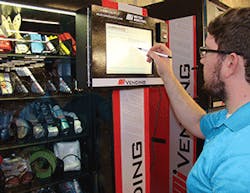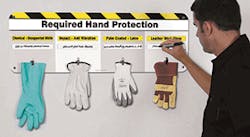Do You Know the Three E's of Hand Protection Management?
At 9 a.m. on the first Monday of each month, I receive a recurring reminder to check the OSHA Enforcement web page for violations. It is a sobering exercise I started years ago that displays a list of OSHA-cited companies and details their penalties and fines. The list is not just isolated to small- and mid-size businesses; it is littered with Fortune 500 companies and the gruesome misfortunes that occur to their employees.
This particular month I read a dozen incidents that resulted in injuries to the hands and arms. Gloves are the most common form of PPE, yet the U.S. Bureau of Labor Statistics (BLS) reports more than 100,000 lost-time hand injuries annually. Open any MRO catalog and you will be deluged with hand protection options that offer thousands of combinations of materials, lengths, dips and degrees of protection.
My question is: Why is a topic that saturates our industry still a leading cause of work-related injuries? There are three areas I have experienced which contribute most frequently to these violations.
Education
I once received a call from a safety manager at a production facility that employs over 1,000 workers. He wanted to increase the cut level of their gloves as they had experienced numerous hand lacerations.
I asked him a couple exploratory questions regarding the cut level and the scale of the gloves he was using: ANSI/ISEA or CE certifications (he wasn't familiar with the difference) and what tasks were being performed when the lacerations occurred (he wasn't sure). Knowing the hazards within a facility and understanding the "how" and "why" are pivotal aspects of a successful safety program.
Ideally, an employer first will do everything he can to completely remove a hazard; PPE should be the final step to protect the worker. Once the determination is made that PPE is to be used, proficiency in the selection process is critical. There are some aspects of which to be aware:
Innovation – It seems that every time I get acclimated to a new phone or device an updated and improved version is released that renders mine obsolete.
Innovation is not unique to the technology sector; glove manufacturers continuously are developing new materials, dips and coatings that allow for better protection, comfort and durability. You weren't content in keeping that flip phone – why keep antiquated technology in your safety program? Learn about new tech and innovations when it comes to your employees' hand protection.
Best practices – One of the benefits of working for an industrial safety distributor is the diversity of industries, companies and people with whom I get to partner. I have insider knowledge about how hundreds of companies run their safety programs. There are a lot of innovative, successful safety practices that can be duplicated in other facilities and industries.
We frequently host customers at other customer sites in order to show best practices and programs we have implemented. Few hazards are unique to only your facility. Communicating with other safety professionals is a productive approach to share experiences and solutions.
Policy – Some major changes have occurred in safety policy over the past months.
The glove rating amendments in ANSI/ISEA & EN388 have created a more consistent rating system and allow more specific hand protection selections. The resulting scales reduce the chance of insufficient or overprotected hand protection… if selected properly.
Comprehending and implementing correct hand protection that adheres to current regulations should not be approached passively. Infractions can result in steep monetary consequences by OSHA and a public relations nightmare.
Most safety professionals know, understand and devote themselves to the exercise of continuous education. It is imperative to stay competent in the changing world of safety regulations, as not having the correct protection can be just as bad as having no protection at all.
Enforcement
The need for enforcement can be illustrated by one statistic from the BLS: 70 percent of lost time due to hand injuries occur while the employee is not wearing gloves. I have yet to enter a facility where the company does not provide gloves. Further, most facilities have a glove policy in place.
These accidents too frequently occur as a result of employee negligence. The enforcement aspect of any safety program seems to be the most challenging. The complexity of regulating not only who is required to wear gloves and when, but also making sure that they are wearing the required gloves for a particular task is extremely difficult.
However, here are several ways that safety professionals can maximize the efficiency of their hand protection program in the face of these challenges:
Safety meetings – Scheduled, recurring safety meetings with your workforce is critical to the success of any safety program. They allow you to effectively communicate relevant data, changes to the safety program or procedures, conduct trainings and launch initiatives. Most importantly, they help establish a structured safety culture within your facility. The safety culture of an organization is a constant reinforcement to employees of the value and importance they play in the overall safety of the facility.
Evaluation
The industrial safety landscape is meant to be dynamic. Too often, we see companies with the same safety procedures, PPE and attitude they had a decade ago.
A change in machinery, lines or tasks can produce new hazards that necessitate deviation from your current hand protection program. Quoting practices further perpetuates this lack of evolution as most distributors are forced to quote "apples to apples" or exact alternatives without understanding the needs of the customer, tasks or hazards, or even if the gloves they are providing is adequate to meet the needs of the workers.
Companies get stuck in a transactional cycle of quoting, awarding and purchasing the same (incorrect) glove for years without proper evaluation of their facility and hazards. It is the responsibility of the employer to provide the correct PPE to their employees. OSHA very clearly states that for general industry:
1910.138(a) – General requirements. Employers shall select and require employees to use appropriate hand protection when employees' hands are exposed to hazards such as those from skin absorption of harmful substances; severe cuts or lacerations; severe abrasions; punctures; chemical burns; thermal burns; and harmful temperature extremes.
1910.138(b) – Selection. Employers shall base the selection of the appropriate hand protection on an evaluation of the performance characteristics of the hand protection relative to the task(s) to be performed, conditions present, duration of use and the hazards and potential hazards identified.
Many distributors and glove manufacturers offer safety assessments and recommendations at no charge. These detailed audits are performed on-site at customer locations and result in a written recommendation of the hand protection to use with each hazard and samples for a trial period. Take advantage of your partnerships with distributors and glove manufactures to provide your employees with appropriate hand protection.
Sean Barbeau, QSSP, is an industrial and safety product specialist at Motion Industries. He can be reached at [email protected]. Learn more at www.MotionIndustries.com and www.MiSafetySpecialist.com.


